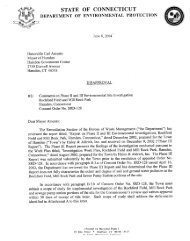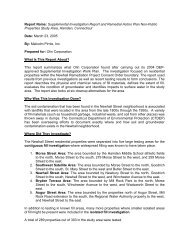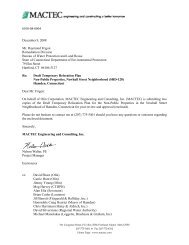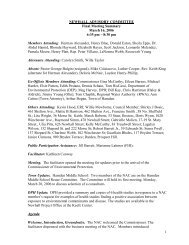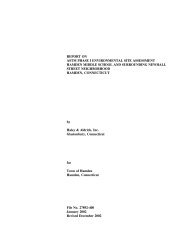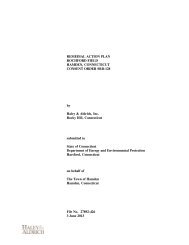Main Report - Newhall Remediation Project
Main Report - Newhall Remediation Project
Main Report - Newhall Remediation Project
- No tags were found...
Create successful ePaper yourself
Turn your PDF publications into a flip-book with our unique Google optimized e-Paper software.
DiscussionThis section presents results from environmental sampling. Environmental data are presented anddiscussed along with relevant health-based comparison values. Comparison values are screeninglevels, below which, there is little likelihood of adverse health effects from exposure. Whencontaminant concentrations are below comparison values, no further evaluation for human healthis necessary and it can be concluded that adverse health impacts are not likely. Whencontaminant concentrations exceed comparison values, it indicates that further evaluation ofexposures and health impacts is needed. Comparison values used in this PHA are from theConnecticut <strong>Remediation</strong> Standard Regulations (CT RSRs) residential direct exposure criteriafor soil (CT DEP 1996). Comparison values are presented in the data tables in the EnvironmentalData section.Trigger concentrations were another set of values used to evaluate soil data from the <strong>Newhall</strong>Street neighborhood. These are not the same as comparison values. Trigger concentrations arelevels that indicate the need for immediate action by EPA to reduce exposure. Triggerconcentrations used for the <strong>Newhall</strong> Street neighborhood soil data were developed by CT DPHand EPA for this project. They are higher than CT RSRs because they indicate wherecontaminant levels are so high that immediate action is needed. As discussed in greater detail inthe following section, EPA used the trigger concentrations to identify which properties neededimmediate soil removal actions.Exposure pathways (i.e., ways people could come into contact with contamination) and thepublic health significance of these exposures, along with an evaluation of available healthoutcome data, are also discussed in this Section.Environmental DataAs mentioned in the Background Section, state and federal agencies have conducted soilsampling in the <strong>Newhall</strong> Street neighborhood on several occasions. CT DEP conducted the initialsampling effort in January 2001, focusing on public right-of-way grass strips between thesidewalk and road in locations believed to have received fill. This was followed by EPAsampling of surface soils to identify properties where immediate action was necessary. AfterEPA completed its surface soil sampling effort, CT DEP continued to sample soil at propertieswho requested soil sampling. The final dataset evaluated in this PHA consists of soil samplescollected by the Olin Corporation in August 2002.CT DEP Right-Of-Way Soil SamplingBeginning in January 2001, CT DEP collected surface soil samples (0–6 inches below groundsurface) from 65 locations in right-of-way grass strips. At eight of these locations, soils at depthwere collected as well. Depth samples were collected as much as 12 feet below ground surface.Samples were analyzed for total metals, pesticides, semivolatile organic chemicals (SVOCs),volatile organic chemicals (VOCs), and extractable total petroleum hydrocarbons (ETPH).In the right-of-way samples, polycyclic aromatic hydrocarbons (PAHs) were the contaminantsfound most often at levels exceeding health-based comparison values (15 out of 65 samples).9



